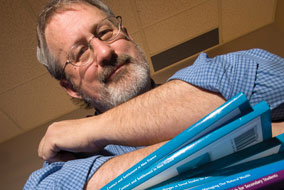
UBC Okanagan education prof. Phil Balcaen - photo by Tim Swanky UBC Reports | Vol. 52 | No. 1 | Jan. 9, 2006
Critical Thinking Goes Beyond Borders
UBC Okanagan professor expanding critical thinking exchange between India and Canada
By Bud Mortenson
Phil Balcaen has traded the past two December holiday seasons in Canada for a chance to help several schools in India weave critical thinking into the fabric of their curriculum. It’s the beginning of what he hopes will become a broad, ongoing exchange of educators from India and Canada, sharing their classroom experiences with critical thinking.
“This project is about embedding critical thinking throughout the curriculum,” says Balcaen, an associate professor with UBC Okanagan’s Faculty of Education. “It means changing curriculum for an ongoing focus on critical thinking, and changing the culture of the classroom.”
Invited by the principals of Indian elementary and high schools interested in producing more critically minded students, on his month-long visits Balcaen holds intensive workshops with small groups of teachers at each participating school. Over three days, he introduces classroom-based teaching methods developed by the Critical Thinking Consortium, a non-profit association of more than 30 B.C. school districts, faculties of education and other educational organizations.
Balcaen was a high school math and science teacher and program administrator in B.C. for 20 years before earning his PhD, researching how schools and universities can collaborate on school reform. In addition to his annual visits to India, he is working with organizations across Canada keen on expanding the role of critical thinking in high school curriculum.
In the 1800s, the British introduced to India a rote learning system emphasizing memorization and exam performance. Education has come a long way since then. Today, teachers in India -- and Canada, for that matter -- want to spark more student creativity and critical analysis. Balcaen says some kinds of problem-solving “are not attended to very well in conventional teaching. You have to teach people how to ask questions a certain way.
“We are teaching them what criteria for judgment are, a critical thinking-related vocabulary, and habits of mind that help kids become critically minded,” he says, explaining that critical thinking isn’t a skill you learn. Rather, it is a set of intellectual tools used in solving critical challenges.
A teacher who can devise meaningful challenges can better engage students with the curriculum and to think critically. Alas, says Balcaen, conventional teaching too often lacks these critical challenges.
For example, in a conventional classroom, science students might be asked to name a list of pollutants mentioned in a report they’ve read. To elicit critical thinking, a teacher might instead ask them to use justifiable criteria to rank the pollutants in order of the danger they pose to the environment, and choose the top two -- and only two -- on which to spend a limited budget for cleanup.
He points out that while critical thinking is studied by academics in many places, the Critical Thinking Consortium is a leader in developing ways to put critical thinking into real-world classroom practice.
“We have taken a set of ideas and adapted them to make them usable in classrooms,” he says. “The translation of these ideas into pedagogy is where we’re different. The activities are all developed by practicing teachers, not by academics. They’re then tweaked and fortified -- tweaked so they don’t have just one right answer, and fortified by including the use of intellectual tools.”
Balcaen works with schools such as Vivek High School in Chandigarh, and India’s historic first public school, the Doon School in Dehradun. He has observed that critical thinking approaches apply just as well in a classroom in Chandigarh or Dehradun as they do at a high school in Prince George, B.C. Now, with the experience of two holiday-season visits to Indian schools, Balcaen hopes to hold a critical thinking symposium at UBC Okanagan to expand the exchange of teachers and knowledge from Canada and India.
“One of my goals is to build a program that allows more exchange with our faculty going there, and teachers from there coming here,” he says. He is already linking teachers using special online knowledge-sharing tools, which has maintained momentum for the project in the Indian schools.
And momentum is important.
“We have learned that you can’t do a workshop, then go away, and expect something to happen,” Balcaen observes. “It takes repeated visits -- each session reinforcing and deepening teachers’ understanding of the concepts being taught.”
Participants in India have made a five-year commitment to the critical thinking initiative. “They are learning to do this work with others,” he says. “It’s a very structural and cultural approach to education reform.”
Future research will determine how -- and by how much -- students improve academically after becoming critical thinkers, but Balcaen says there’s plenty of anecdotal evidence to suggest students and schools benefit.
“The agenda here is to support people to be more thoughtful,” he says. “From an education perspective, the greatest thing we’re finding is that kids in Canada and in India are far more engaged in their learning process.”
Putting Critical Thinking Tools into Practice
Who had a more significant impact on the colonization of New France -- the fur traders or church missionaries?
That’s the critical challenge posed by one activity in the widely used Critical Challenges curriculum for Grade 9 social studies, published by Rich Thinking Resources, an initiative of Richmond, B.C.’s School District 38.
There may be no single “right” answer, but the process of responding to the challenge is where a lot of learning can take place. Exploring how fur traders and missionaries influenced the colonization of the region in the mid-17th century, students are challenged to use a variety of intellectual tools -- background knowledge, criteria for judgment, a vocabulary, thinking strategies, and the habits of mind they have developed to be critically minded -- to come up with a well-reasoned response to the challenge. |
